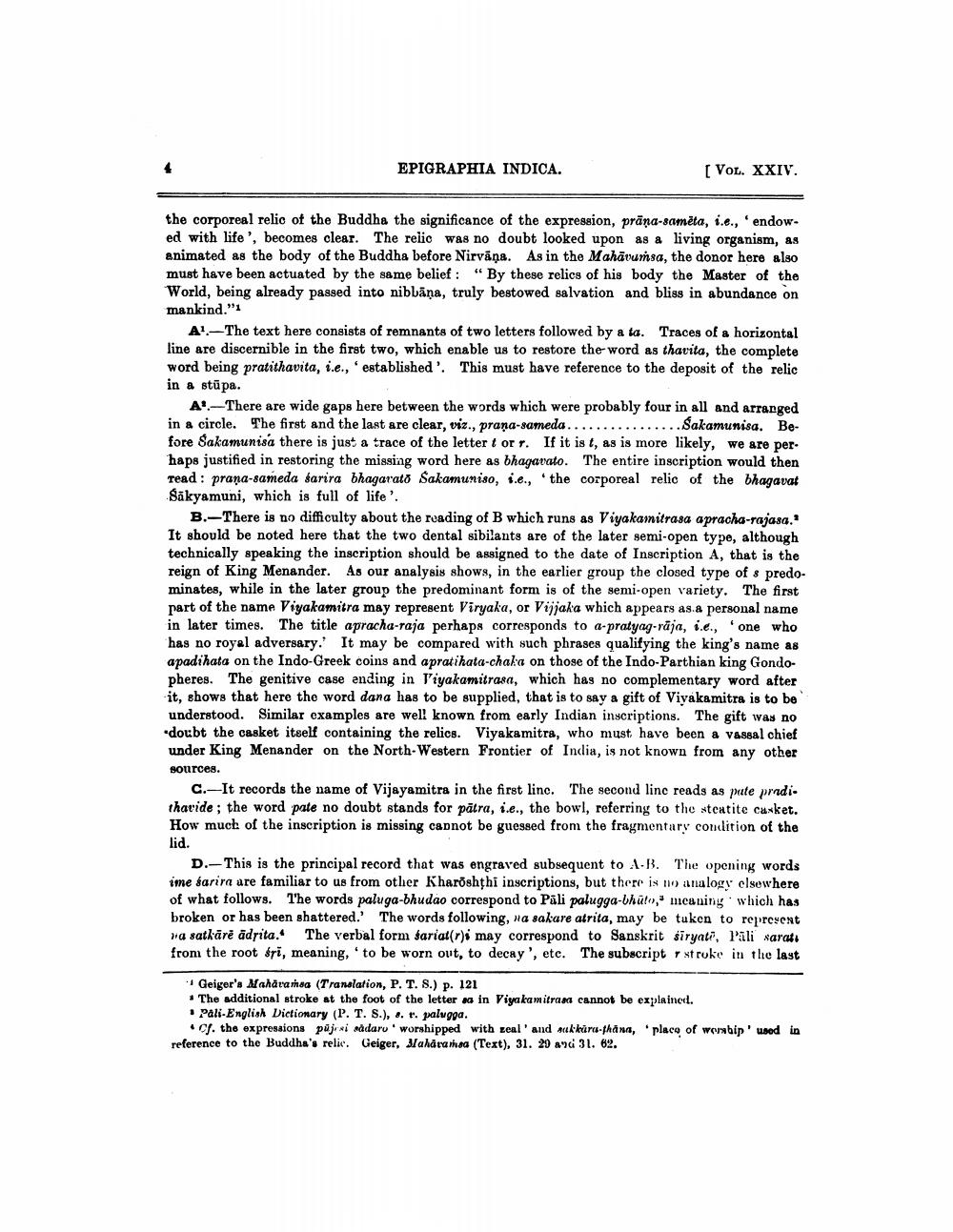________________
EPIGRAPHIA INDICA.
[ VOL. XXIV.
the corporeal relic of the Buddha the significance of the expression, präna-samēta, i.e., endow. ed with life', becomes clear. The relic was no doubt looked upon as a living organism, as animated as the body of the Buddha before Nirvāņa. As in the Mahāvunsa, the donor here also must have been actuated by the same belief: "By these relics of his body the Master of the World, being already passed into nibbāņa, truly bestowed salvation and bliss in abundance on mankind."1
A'.-The text here consists of remnants of two letters followed by a ta. Traces of a horizontal line are discernible in the first two, which enable us to restore the word as thavita, the complete word being pratithavita, i.e., established'. This must have reference to the deposit of the relic in a stūpa.
A'.--There are wide gaps here between the words which were probably four in all and arranged in a circle. The first and the last are clear, viz., prana-sameda......... ...... Sakamunisa. Before Sakamunisa there is just a trace of the letter torr. If it is t, as is more likely, we are per. haps justified in restoring the missing word here as bhagavato. The entire inscription would then read: prana-sameda sarira bhagarato Sakamuniso, i.e., the corporeal relic of the bhagavat sākyamuni, which is full of life'.
B.-There is no difficulty about the reading of B which runs as Viyakamitrasa apracha-rajasa. It should be noted here that the two dental sibilants are of the later semi-open type, although technically speaking the inscription should be assigned to the date of Inscription A, that is the reign of King Menander. As our analysis shows, in the earlier group the closed type of s predominates, while in the later group the predominant form is of the semi-open variety. The first part of the name Viyakamitra may represent Viryaka, or Vijjaka which appears as a personal name in later times. The title apracha-raja perhaps corresponds to a-pratyag-raja, i.e., one who has no royal adversary. It may be compared with such phrases qualifying the king's name as apadihata on the Indo-Greek coins and apratihata-chaka on those of the Indo-Parthian king Gondo
pheres. The genitive case ending in t'iyakamitrasa, which has no complementary word after -it, shows that here the word dana has to be supplied, that is to say a gift of Viyakamitra is to be understood. Similar examples are well known from early Indian inscriptions. The gift was no doubt the casket itself containing the relics. Viyakamitra, who must have been a vassal chief under King Menander on the North-Western Frontier of India, is not known from any other sources.
C.-It records the name of Vijayamitra in the first line. The second linc reads as pate pradi. tharide; the word pate no doubt stands for pătra, i.e., the bowl, referring to the steatite casket. How much of the inscription is missing cannot be guessed from the fragmentary condition of the lid.
D. - This is the principal record that was engraved subsequent to A.B. The opening words ime sarira are familiar to us from other Kharoshthi inscriptions, but there is no analogy clsewhere of what follows. The words paluga-bhudao correspond to Pāli palugga-bhato, meaning which has broken or has been shattered.' The words following, wa sakare atrita, may be tuken to represent va satkārë adrita. The verbal form sariat(r)i may correspond to Sanskrit siryati, ali sarafı from the root fri, meaning, 'to be worn out, to decay', etc. The subscript stroke in the last
Geiger's Maharansa (Translation, P. T. S.) p. 121 * The additional stroke at the foot of the letter sa in Viyakamitrasa cannot be explained. • Pali-English Dictionary (P. T. S.), •. t. palugga.
* Cf. the expressions püjeni radaru worshipped with zeal' and nuk kiruthana, place of worabip' used reference to the Buddha's relie. Geiger, Sahararea (Text), 31. 29 au 31. 62.
in




